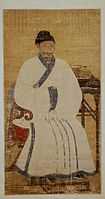
Shenyi (深衣) - formal wear for men
Shenyi (深衣) is the traditional Chinese attire for men which is recorded in Book of Rites and advocated in Zhu Xi's Common Rites. [1]It has been the formal wear and court dress since Shang Dynasty. It was a form of formal wear for the scholar-official in Song Dynasty and Ming Dynasty. It was also introduced to Korea and Japan and exerted great influences on Hanbok and Kimono. The Shenyi Center of Chinese Medicine is named after it.
Design of Shenyi
Shenyi in later dynasties directly descended from the shenyi worn in earlier dynasties, like Han Dynasty. Shenyi originally is made of ramie cultivated in China. Ramie fabric needs to be bleached and produced 45 to 60 centimeters wide textile. The yi (衣, blouse) and chang (裳, skirt) of the shenyi is sewn together. The upper part is made up of 4 panels of ramie fabric, representing four seasons of a year. 2 panels are fold and sewn to cover the upper body. Another 2 panels of ramie fabric are sewn onto each side of the yi as two sleeves. The lower part is made up of 12 panels of fabric sewn together (十二片縫合), representing 12 months a year. Its sleeves are wide with black cuff. A wide sash (大帶) is tied in the front.
Decline of Shenyi
Popularity of shenyi declined during Tang Dynasty, and by the Ming Dynasty, it was advocate worn only for the most formal occasions, such as ceremonies to pay respects to the ancestors (祭祖) or worn as funeral cloth (斂衣). However, the actual usage are worn as inner garment for Yan Bian(燕弁冠服 for Emperor), Bao He(保和冠服For Princes), Zhong Jing(忠靜冠服 for Imperial Officers) only. Shenyi was considered too ancient and meaningful to wear in Ming Dynasty. But it is popular with Confucian scholars. Even Korean and Japanese Confucian scholars were dressed up with Shenyi to show their dedication to the way of ancient saints.
| Portrait of man wearing shenyi |
| Korean Confucian scholar Seo Jik-su |
| Korean Confucian scholar Yi Je-hyun |
| Korean Confucian scholar Song Siyeol |
|
References
See also
- Han Chinese clothing
- List of Han Chinese clothing


















